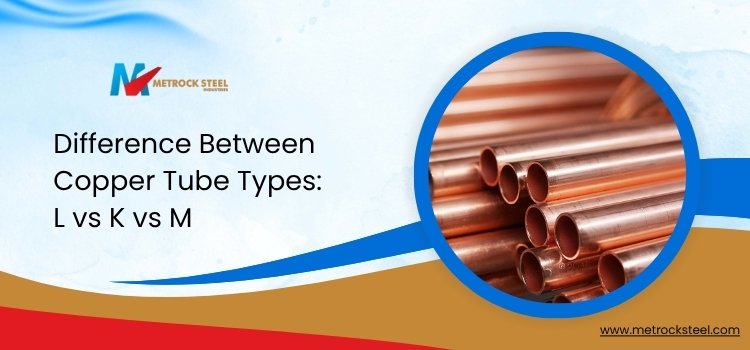The main differences between the various types of copper tubes are detailed below. Copper tubing is a typical plumbing, HVAC, and industrial commodity, but not all copper pipes are created equal. The three primary types, K, L, and M, differ in terms of wall thickness, strength, and use. Understanding the Difference Between Copper Tube Types – L vs K vs M allows you to select the best one for your individual application, assuring long-term performance, safety, and cost-effectiveness.
Why Copper Pipe Types Matter in Plumbing and HVAC Systems?
Types of copper piping should also be chosen with a lot of care in order to use in water supply, air conditioning, and refrigeration. The properties are unique to each type of pipe (M, K, and L), which also affect their performance, pressure rating, and corrosion resistance.
Choosing the right type means:
- Leaking and ruptured pipes under pressure are avoided.
- Extending the functional life of an existing plumbing or HVAC system.
- Meeting construction and safety regulations.
- Installation expenses will be decreased, and materials will be used efficiently.
Understanding Copper Tube Types – L vs K vs M
Type K Copper Tube (Heaviest Duty)
- Wall Thickness: The fattiest of fats.
- Colour code: green.
- Uses: Applications include subsurface water service, commercial plumbing, and industrial usage.
- Advantages: The highest pressure rating to ensure the longest life; best suited to heavy-duty applications.
- Weaknesses: It is not as lightweight as paper and cannot be bent readily due to its thickness.
Type L Copper Tube (Medium Duty)
- Wall Thickness Types K and M are intermediate.
- Color code: blue.
- Uses: include residential water supply, interior plumbing, and HVAC systems.
- Advantages: The best price-to-life ratio.
- Contraindications: Cannot be used in underground or high-pressure industrial settings.
Type M Copper Tube (Light Duty)
- The thinnest of the three walls.
- Color code: red.
- Uses: low-pressure household pipes, such as water heating or venting.
- Advantages: Low cost and simple installation.
- Limitations: Cannot be used in high-pressure systems or outdoors.
Copper Tube Identification Made Simple
Color codes will almost always be visible on-site for identifying copper tube kinds. Green for Type K, Type L is shown in blue, while Type M is represented by red. Additionally, producers emboss or print the K, L, or M designation directly on the tube to ensure accurate selection during installation.
Conclusion:
Understanding the differences between copper tube types (L, K, and M) allows you to make an informed decision about which tubes to install in your plumbing or HVAC system. The types serve diverse functions: Type K is employed in heavy-duty applications, Type L in ordinary residential settings, and Type M in light-duty systems. Choosing the right copper pipe ensures better performance, longevity, and a lower cost for your project.
FAQ Section
Q1. What is the primary difference between copper tube types L, K, and M?
The key distinction is in the thickness of the wall and its use. The thickest and strongest is Type K, moderately thick and good for residential use is Type L, and the slenderest and good to use in low-pressure systems is Type M.
Q2. What is the best copper pipe to use in plumbing?
Type L copper pipes are the most commonly utilized in household plumbing due to their durability, moderate price, and easy installation.
Q3. Is it possible to use Type M copper pipes to supply water?
Yes, but only for low-pressure residential water systems. Types L or Type K are to be used in high-pressure or underground lines.
Need expert guidance on choosing the right copper tube type for your project? Whether it’s Type K, L, or M copper pipes, our team is here to help you find the perfect fit for your plumbing or HVAC needs. Email us at sales@metrocksteel.com or contact us today to get reliable copper solutions that ensure performance and durability.

